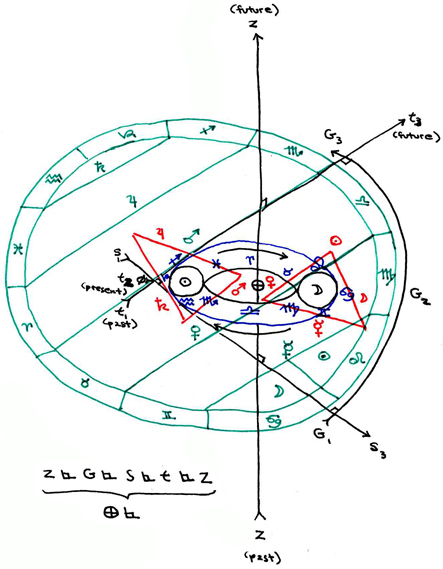------------------------------------------------------------------------------
------------------------------------------------------------------------------
4D CONE
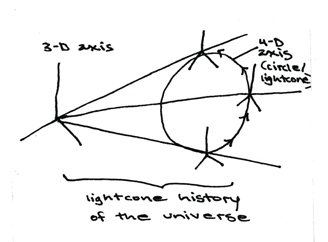
to measure the relativity of three points at one time, construct one three-dimensional axis for all three, then trace out the point of intersection for one random angle from each point, and construct an axis system for this point. To measure a duration, follow the same procedure for a single point at three different times.
The circle of the base of this cone will always be a measure of the fourth dimension. It acts as an angle at which the three other directions meet, a plane connecting them all as a tetrahedron. For example, in a 3-sphere, this angle is confined to 45 degrees of the circumeference of the sphere for 3 right angles.
------------------------------------------------------------------------------
------------------------------------------------------------------------------
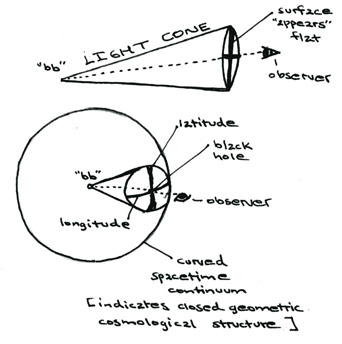
The Einstein-Hubble cosmology of the universe is a simple enough one for most people to understand.
The "big bang" began with a singularity, and the universe expanded out from there.
Therefore, we can look at the history of the universe as a "light cone" where we can look backward from our present universe (indicated by the eye in the diagram).
Einstein proposed in general relativity that the surface of space-time was curved by mass. Edwin Hubble furthered this idea when he discovered the spectral red-shift of galaxies. The point of intersection between Einstein's theory and Hubble's observation is that the present surface of the expanding universe is spherical. This would place the "big bang" at its core (indicated by the observer's eyeline).
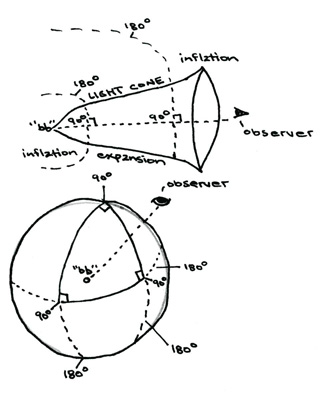
Stephen Hawking expanded upon these ideas in modelling his cosmology of the universe. He expressed the Einstein-Hubble light cone as bowed in shape, between the early inflation, expansion, and later inflation periods.This would indicate alterations in the rate at which the universe was expanding. He calculated that an observer looking down into a black hole would be able to see to the point of singularity, at which spacetime became infinitely distoted by gravity. His theories contributed to the search for the point of unification of the four elemental forces and the discovery of blackholes with gas jets at the center of spiral galaxies.
Roger Penrose worked with Stephen Hawking on developing a general cosmology based on these observations. They came to the conclusion that the best model of the lightcone might be tetrahedral, based on great arcs drawn around the circumference at 90 degree angles to one another. This compactified frame has already been proposed to account for the collapse of only certain dimensions due to the contraction of superstrings. I call this the conservation of dimension.
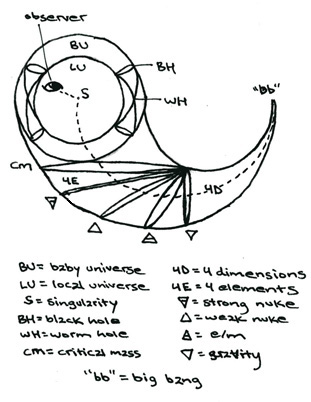
This is my own personal model. You may recognise it (though only very small) from the center of tau-sub-tau. Here it is enlarged and labeled. I believe it should more or less speak for itself.
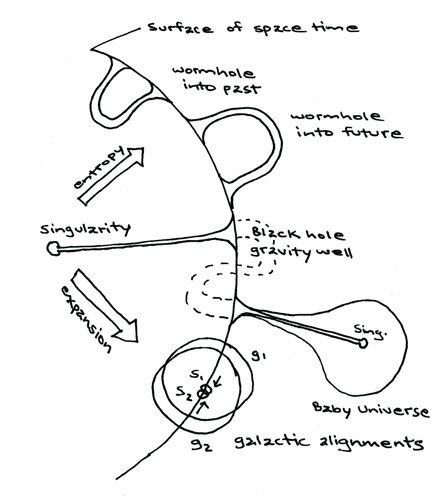
Some features that all of these cosmological models share in common are depicted here. The local universe has conservation of curvature. It expands due to entropy. By moving faster than entropy, one will enter a wormhole into the future, and by moving slower than entropy, a wormhole into the past. Every blackhole leads to the same singularity at the origin point of our universe. Through the singularity, quanta are fed into the flow of entropy and collect cosmic dust in their electromagnetic fields. This cosmic dust forms a galaxy, and when two or more galaxies align, then the view from the center of each will be as though seeing forward and backward in time simultaneously.
------------------------------------------------------------------------------
------------------------------------------------------------------------------
ANGLE OF TIME
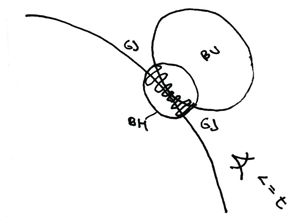
here we see that the gas jets of a black hole extend out at different angles from the poles due to polar precession. When the gas jet's angle of arc is attracted toward the black hole at the center of another galaxy (thus forming a "baby universe" between the two galaxies) then the angle of the arc is actually much smaller than the angle of arc connecting the gas jet around toward the pole of a star in the galaxy of which the black hole is its center.
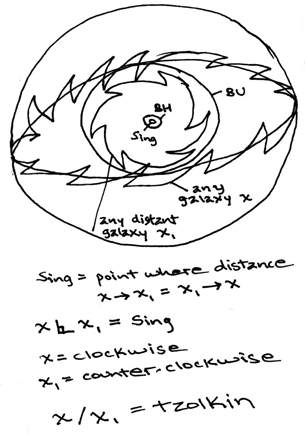
here we see that a "baby universe" (or networked connection between two or more galaxies within one overall parent universe) is formed when any of the listed conditions is met.
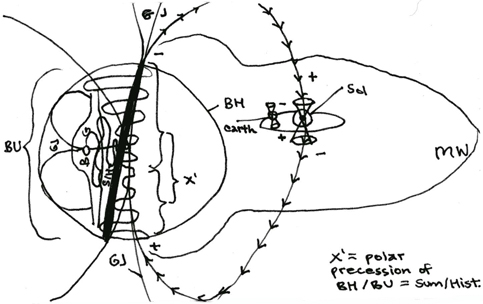
Discuss this section on the forums
------------------------------------------------------------------------------
------------------------------------------------------------------------------
A NAME=GRAV>GRAVITY=TIME

This diagram represents the four stations of earth in orbit around the sun at the four stations of the sun's orbit around galactic core (labeled BH at center).The substations in between the sun stations represent the precession of the poles of the black hole's axis and it's reversal between electromagnetic south and north, being other names for positive (plus) and negative (minus). Consequently all of the polar pressions depicted for the sun and for the earth in their respective stations are determined roughly according to the arrangement in the following diagram.

Here we see that, when North equals "positive" then the northern pole of earth will be attracted toward the sun, that the northern pole of the sun will be attracted to galactic core, and the northern pole of galactic core will be facing in the same direction as toward the sun.

And here is a diagram that depicts this relationship from a sideways vantage. Here, we see the blue and green wavelengths are equivalent to gravity waves, or tachyons, which are oriented perpendicularly to one another. The green waves are a rough approximation because of the rotation of the arms of the galaxy, and the blue waves are a rough approximation because of the varying degrees of thickness of the galaxy's spiral arms. Between these two, and perpendicular to both of them, is the average field that exists between them. Depicted in red, it displays one quadrant of a full corscrew spiral down the length of wave A and B. This one quadrant represents one of the four "positive," "negative," "north" or "south" orientations of the bodies' poles in their respective stations.
When the field (red average of blue and green waves) = "positive," then the sun and earth's same hemisphere will be oriented toward one another, and the sun and galactic core's poles will also be oriented toward one another in the same hemisphere.
In this diagram we see the precession of earth's polar orientation relative to the ecliptic (blue) zodiac. We can also extrapolate from this diagram the orientation of this (or any) combination of earth's polar precession [relative to orbital perihelion (equinox) and aphelion (solctise)] and the duration of rotation of our solar system around galactic core (green zodiac). In other words, the blue zodiac can simultaneously stand for earth's orbit around the sun and the ecliptic zodiac of our solar system, and the green zodiac represents the plane of the Milky Way galaxy seen from our solar system as we orbit within it around galactic core.
So, the Z axis is perpendicular to the plane of the galaxy (G), which is perpendicular to the plane of the solar system (S), which is perpendicular to the direction of the rotation of the solar system around galactic core (t), which is perpendicular to the orientation of the poles of earth relative to those of galactic core (Z). Of course, the equator of earth is also perpendicular to all of these, although, this "prime" measure of perpendicularity obviously only occurs from time to time, and the rest of the time these measures are not in such an exact alignment. In any event, this model describes in its motion the way to symbolically predict all net astrological alignments possible involving gross galactic astronomy.
Discuss this section on the forums
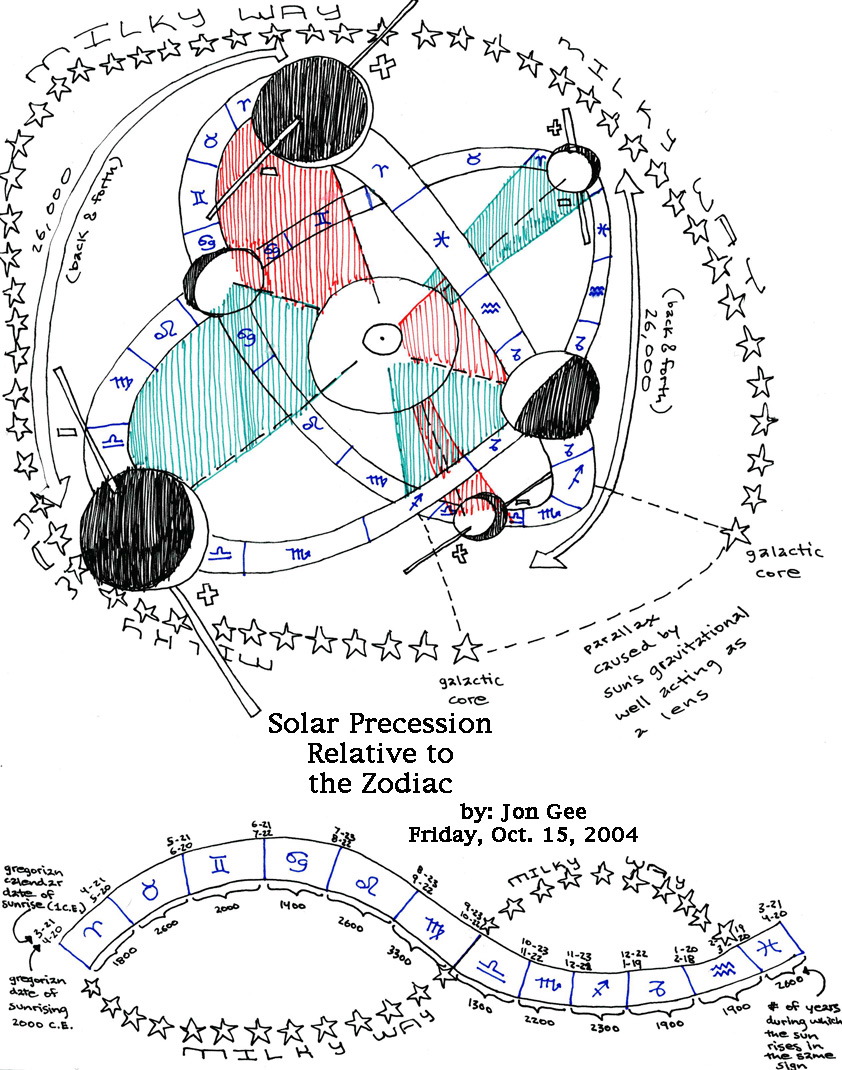
In the top diagram we see the earth (shadowed by night) rotating around the sun, clearly marked, at the center. The orbital path of the earth around the sun is depicted as the zodiac, although the ecliptic plane of the zodiac, technically, does differ somewhat from our own current equator. The poles of the earth are shown on the outer four stations, and labeled positive and negative. It should be noted that the positive and negative stations reverse depending on whether the earth is ascendant or descendant to the equator of the sun. Because the planet's orbit is reckoned to be more elliptical than oblate, the red and green shaded ratios on the diagram represent the porportions of Kepler's Third Law of motion by which to guage the duration of time taken, and thereby the speed, of the planet in one of said positions. The time it takes for the orbital plane of earth around the sun to precess from the plus to the minus electromagnetic polarity is approximately 26,000 years, or about twice the time it takes for the geographic pole to precess around in one full rotation. The reason for this will be explained in the following images.
At the bottom of the page is another diagram, however what it depicts is clearly labeled.
----------------------------------------------------------------------------------------------------------------